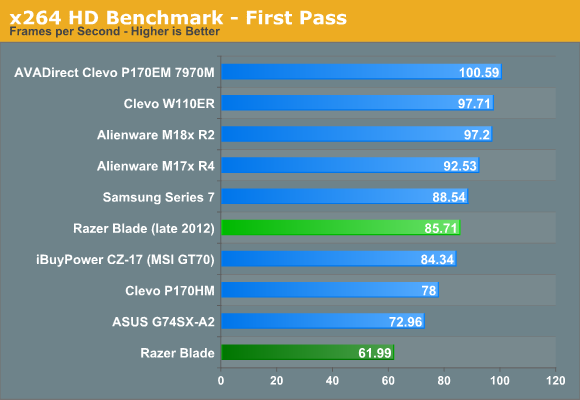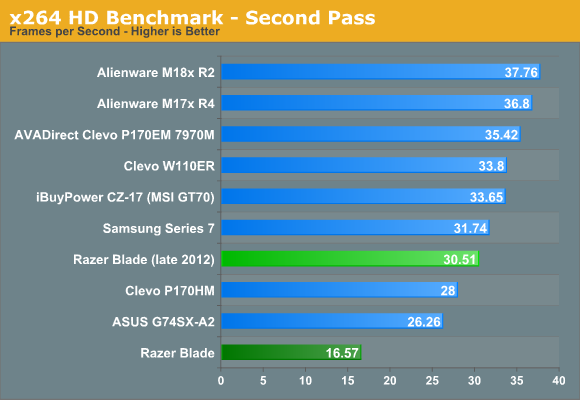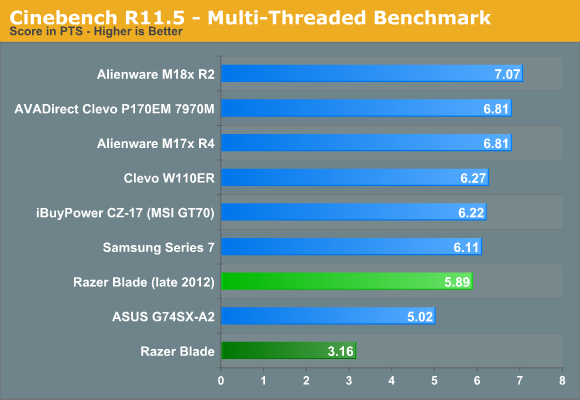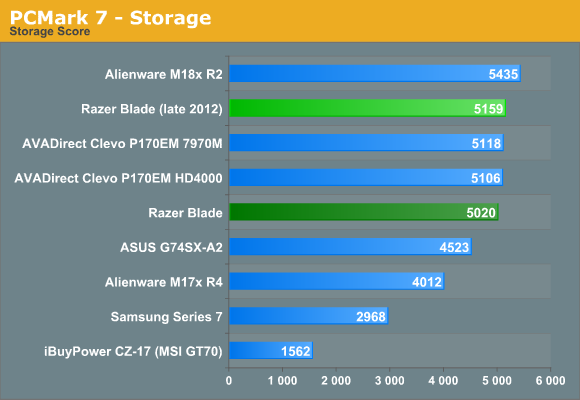The New Razer Blade: Thoroughly Reviewed
by Vivek Gowri on October 3, 2012 5:40 PM ESTRazer Blade (late 2012) - Performance
To gauge how the new Blade stacks up versus its predecessor and other gaming-class notebooks, we picked a decent selection of systems with the entire range of modern GPUs, from the GT 650M GDDR5 in Samsung's Series 7 to the pair of Alienware systems with GTX 680M and 680M SLI graphics configurations. There's a decent range of storage technologies on display here as well, with a number of different SSDs and hybrid storage solutions, along with one conventional 7200RPM hard drive.
| Notebook Configuration Overview | ||||
| CPU | Graphics | Storage | Battery | |
| Alienware M17x R4 | i7-3720QM | GTX 680M | Hybrid (Intel SRT) | 90Wh |
| Alienware M18x R2 | i7-3820QM | GTX 680M SLI | 2x SSD 830 (RAID) | 97Wh |
| ASUS G74SX-A2 | i7-2630QM | GTX 560M | Intel 320 SSD | 90Wh |
| AVADirect Clevo P170EM | i7-3720QM | HD 7970M | Crucial M4 SSD | 77Wh |
| Clevo W110ER | i7-3720QM | GT 650M | Hybrid (Momentus XT) | 62Wh |
| iBUYPOWER MSI GT70 | i7-3610QM | GTX 675M | 7200RPM HDD | 60Wh |
| Razer Blade | i7-2640M | GT 555M | Lite-On M2S SSD | 60Wh |
| Samsung Series 7 | i7-3615QM | GT 650M | Hybrid (ExpressCache) | 77Wh |
| Razer Blade (late 2012) | i7-3632QM | GTX 660M | Hybrid (DataPlex) | 60Wh |
The Blade is the first 35W quad that I’ve dealt with, and it’s the only 35W quad to go through our labs since Dell’s XPS 15 a few months ago. The Blade uses a new OEM-specific i7-3632QM that is essentially the same as the i7-3612QM in the Dell, except with 100MHz faster clocks. Performance-wise, it falls in roughly where you’d expect a 2.2GHz Ivy Bridge quad, a bit faster than the SNB quads and the 2.1GHz i7-3612QM but a bit slower than the various IVB quads that are clocked faster, starting with the 2.3GHz i7-3610 and 3615QM. I'm going to skip straight to the CPU testing this time, as I find PCMark 7 to be far too heavily skewed by other factors (SSD, Quick Sync, etc.)




There’s not too much else to say about Ivy Bridge here; it’s just a really solid CPU that’s done well for Intel. The only complaint that really can be leveled against it is that even though the tick+ update focused heavily on a new on-die graphics architecture, Intel is still playing catch up to AMD’s far more advanced integrated graphics solutions. Intel’s HD 4000 is solid enough for anything not involving gaming though, and in these applications at least, it does its job well.
Traditionally, I try to avoid all Futuremark tests, but I decided to break my rule here with the PCMark 7 storage benchmark. I wanted to see how effective NVELO’s DataPlex caching solution was with respect to Intel’s Smart Response Technology as well as the SSD in the previous Blade. The PCMark Storage score is pretty impressive, beating the SRT-enabled Dell XPS 15 (which had a 32GB cache drive) and interestingly, the old Blade as well. Admittedly, the original Blade’s SSD wasn’t the fastest in the world, even though it used the same Marvell controller as the caching SSD in the new Blade (and the Intel SSD 510, amongst other notable SSDs). We saw better Storage benchmark scores out of faster SSDs in the ASUS N56VM, which was tested using a SandForce-based drive, and Alienware M18x R2 (two Samsung SSD 830s in RAID).

It was a pretty impressive showing, and I actually wasn’t put off by the hard drive too much in day to day usage. The one place where I missed the SSD? Shut down/restart and sleep/wake cycles. I timed a cold boot at 20.8 seconds, a solid 5 seconds off the pace of the old SSDified Blade, and it was definitely something you were reminded of every time the system was rebooted or woken from sleep. As much as the new caching solutions help, nothing can touch the outright responsiveness of a real SSD.










59 Comments
View All Comments
Cutebone - Wednesday, October 3, 2012 - link
"I'd also like to see an optional SSD-only configuratoin"Thanks for the write-up...wish I had $2,500 to spare...
robmuld - Wednesday, October 3, 2012 - link
I wish they offered a 16:10 option. Also, a proper navigation keys (PgUp/Dn and Home/End) section on the keyboard. This has sadly disappeared from most mobile keyboards nowadays, whereas it was more common years ago.andykins - Wednesday, October 3, 2012 - link
Great notebook and great review. I'm really glad you decided to dump PCMark7. I totally ignored the benchmarks from that suite in every review; I actually have no idea why Anandtech includes them, they're totally useless really.I have to say, I think if I had that amount of money to spend I would rather get a rMBP. If money was no object, however, I'd get both! ^^ But it begs the question why you didn't include rMBP (running Win7) in the results when you have a machine at hand? :)
Camacho - Wednesday, October 3, 2012 - link
Why is the Macbook "A different story entirely"? It is pretty much the same damn hardware as the Blade with a slightly slower GPU (GT 650m) and slightly faster CPU at base and all core clock. Blade beats it on single thread by 100MHz. @ 3.4GHz AND is cheaper. Plus it has your IPS display. Just wondering as you can just install Windows on the Mac. IPS laptop display is as fast as anything I have seen in a portable so not sure what the Razer guy was on about. ???.Camacho - Wednesday, October 3, 2012 - link
I was wrong the Macbook Pro has a faster CPU on all counts.will54 - Thursday, October 4, 2012 - link
Actually the Macbook has a faster GPU at there stock clocks since for some reason the MBP has a 165 mhz higher clock speed than other GDDR5 650M's. Not sure why they didn't just go with the GTX 660M.VivekGowri - Wednesday, October 3, 2012 - link
Because it's an OS X-based 15" machine that plays in a completely different size and weight class? You wouldn't compare a Porsche 911 and a Mercedes S-class just because they cost roughly the same and have a similar amount of power, right - same principle applies here.andykins - Thursday, October 4, 2012 - link
I disagree, Vivek. Maybe I am isolated case but I would very much like to see it compared to the rMBP. After all, the Razer is compared to laptops that weigh 3lb (50%+) heavier.VivekGowri - Thursday, October 4, 2012 - link
I dunno, there's just a huge difference between a 4.5lb 15" system and a 6.5lb 17" system in terms of form factor. Add in OS X, and I felt like they were different enough that they wouldn't be cross shopped much. M17x, on the other hand, is probably the biggest competitor for the Blade. The rMBP to me is an amazing system but I can't see a valid comparison. I guess maybe if you wanted the closest thing to the Blade in a 15" form factor, get an rMBP?Flunk - Wednesday, October 3, 2012 - link
It's a shame they don't make a 15" version of this. 17", no matter how thin is just too big to be reasonably portable. Heck, I would buy a 15" version of this at the same price. There really isn't much in that market space right now.